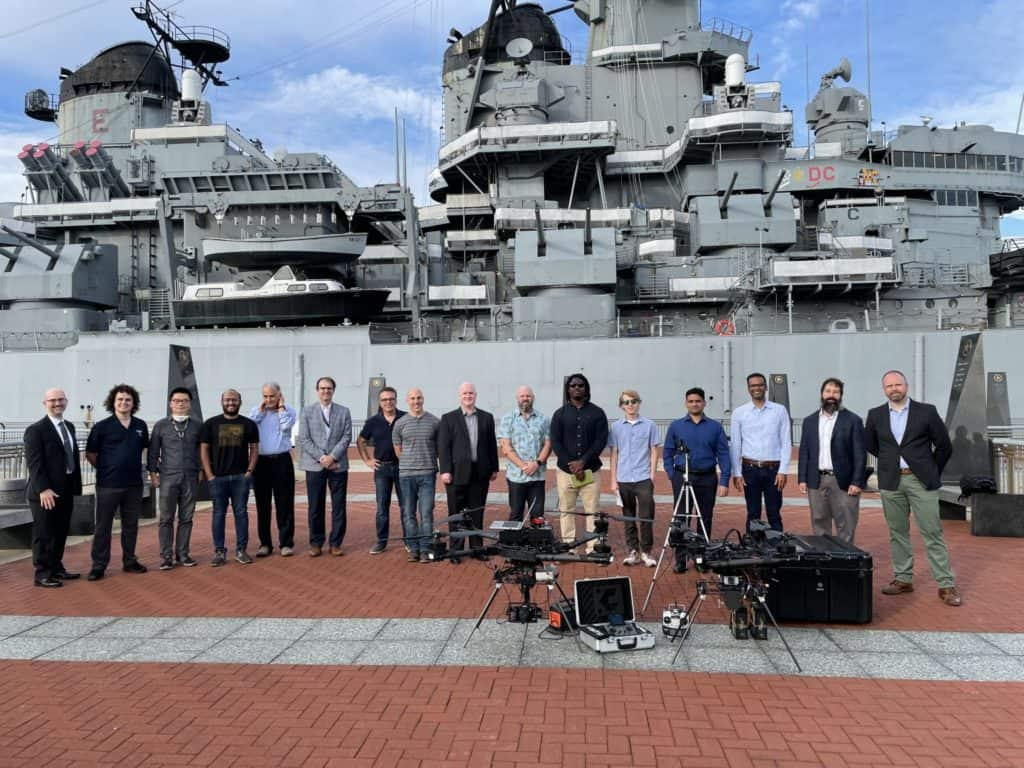This robotics project was funded in collaboration with the JROBOT Group, a Department of Defense taskforce. In February 2020, the ARM Institute hosted and participated in the Joint Summit: Robotics in Sustainment II (JROBOT) event. The four-day summit brought together experts across government and the armed services to develop and recommend Office of the Secretary of Defense (OSD) policies for coordinating and expanding the use of industrial robotics in sustainment activities across all military branches.
As part of the event, the ARM Institute released a Special Call for Technology Projects (ARM-TEC-19-04) focused on supporting Department of Defense sustainment goals. From there, a competitive group of project teams were invited to present their project proposals in-person at the Joint Summit.
Autonomous Drone Inspection Project Background
This project developed an autonomous drone inspection system that uses multimodality aerial imaging from a swarm of autonomous drones to inspect high-rise structures, like navy ships, that are prone to surface defects. ASIIMOV makes this process faster and more efficient by inspecting large portions of the structure at once, through the aforementioned drone swarm.
Objective

Unmanned drone inspection can provide necessary visibility for hard-to-access areas of large equipment that may pose safety or health risks. This project aimed to deploy an inspection method using drones that will provide fast, safe and flexible access for remote viewing and control in real-time with human in the loop for immediate additional inspection decisions (such as viewing of different angles, and expert classification of anomalies) while a fleet of drones is deployed.
The Autonomous Swarm Inspection and Interactive 3D Modelling with Orchestrated Visualization (ASIIMOV) project, funded with support from the Deputy Assistant Secretary of the Navy for Sustainment, has developed autonomous swarm capabilities to significantly enhance the inspection quality and visualization of critical Navy assets.
The program was led by Siemens Technologies, with the support of Allem Business Ventures, and successfully developed multi-drone navigation software, asset survey capability without prior knowledge, high-resolution image acquisition, high resolution 3D model creation, and the use of a mixed reality (MR) interface to operate and interact with a swarm of drones.
Autonomous Drone Inspection Results & Conclusions

This pervasive technology developed through the partnership between the ARM Institute, Siemens Global Technology, and the US Navy, is making automated inspection capabilities of large assets a reality. Autonomous drone inspection methods that have been chosen and demonstrated eliminate the resource intensive processes and facilitate autonomous inspection in complex & remote environments with accelerated high-quality inspection. The Siemens team successfully demonstrated the following multi-drone inspection technology capabilities:
- Reduce the time needed to inspect large assets and assets in complex environments with little infrastructure support (e.g., ships, wind-turbines, off-shore oil-rigs, etc.)
- Improve safety by eliminating manual processes in complex or difficult environments.
- Accelerate the collection of high-quality inspections of critical assets and infrastructure.
This project is based on top of some existing design of Siemens Energy Autonomous drone and Defense Advanced Research Projects Agency (DARPA) OFFensive Swarm-Enabled Tactics (OFFSET) program. The ARM Consortium Intellectual Property (CDIP) developed under this partnership include:
- UAV Navigation Stack: Software that navigates UAVs to obtain the desired viewpoint
- Swarm Autonomy: Software that decomposes high-level tasks into UAV command on swarms
- Augmented Reality / Mixed Reality (AR/VR) Module: Human Machine Interface (HMI) utilize both AR and traditional touch screen
- UAV Reference Design: Reference design including sensors, controllers, motors, embedded
Impact of Autonomous Drone Inspection for the Department of Defense (DoD):
The advancements from this project resulted in reduced costs for sustainment operations, reduced time to execute inspection processes in complex environments with little infrastructure support and increased safety by eliminating manual processes in complex or difficult environments.
Participants in the Autonomous Drone Inspection Project
Siemens (PI), Allem Business Ventures
